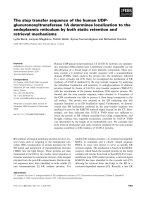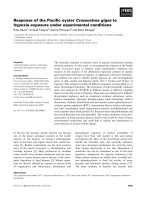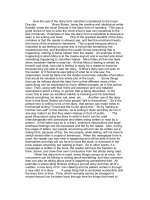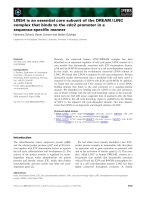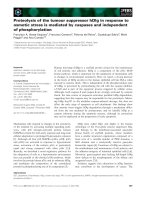rebonato - plight of the fortune teller; why we need to manage financial risk differently (2007)
Bạn đang xem bản rút gọn của tài liệu. Xem và tải ngay bản đầy đủ của tài liệu tại đây (1.82 MB, 303 trang )
Plight of the Fortune Tellers
Plight of the Fortune Tellers
Why We Need to Manage
Financial Risk Differently
Riccardo Rebonato
PRINCETON UNIVERSITY PRESS
PRINCETON AND OXFORD
Copyright © 2007 by Princeton University Press
Published by Princeton University Press,
41 William Street, Princeton, New Jersey 08540
In the United Kingdom: Princeton University Press,
3 Market Place, Woodstock, Oxfordshire OX20 1SY
All Rights Reserved
ISBN-13: 978-0-691-13361-4 (alk. paper)
Library of Congress Control Number: 2007928672
A catalogue record for this book is
available from the British Library
This book has been composed in Palatino
Typeset by T
&
T Productions Ltd, London
Printed on acid-free paper
∞
press.princeton.edu
Printed in the United States of America
10987654321
To my wife
To my parents
To my newborn son
CONTENTS
Preface ix
Acknowledgments xxvii
1 Why This Book Matters 1
2 Thinking about Risk 22
3 Thinking about Probabilities 40
4 Making Choices 67
5 What Is Risk Management For? 107
6 VaR & Co: How It All Started 117
7 Looking Beneath the Surface: Hidden Problems 139
8 Which Type of Probability Matters in Risk
Management? 182
9 The Promise of Economic Capital 199
10 What Can We Do Instead? 223
Endnotes 259
Index 267
PREFACE
[T]here is … considerable danger in applying the method of
exact science to problems … of political economy; the grace and
logical accuracy of the mathematical procedure are apt to so fas-
cinate the descriptive scientist that he seeks for … explanations
which fit his mathematical reasoning and this without first
ascertaining whether the basis of his hypothesis is as broad … as
the theory to which the theory is to be applied.
Karl Pearson, 1889, speaking at the Men’s and Women’s Club
∗
Financial risk management is in a state of confusion. It has
become obsessively focused on measuring risk. At the same time,
it is forgetting that managing risk is about making decisions under
uncertainty. It also seems to hold on to two dangerous beliefs:
first, that our risk metrics can be estimated to five decimal places;
second, that once we have done so the results will self-evidently
guide our risk management choices. They do not. Even if they did,
our risk metrics cannot be anywhere as precise as they are made
out to be. This is not because we must “try harder”—say, col-
lect more data, or use cleverer statistical techniques. It is because,
given the problem at hand, this degree of precision is intrinsically
unattainable.
Given what is at stake, this state of confusion is dangerous. To
get out of this impasse we must tackle the task from a radically
different angle: we must revisit our ideas about probability in
financial risk management, and we must put decision making
back at center stage. This is what this book is about.
∗
Quoted in A. Desrosieres (1998), The Politics of Large Numbers: A History of
Statistical Reasoning (Cambridge, MA: Harvard University Press).
x PREFACE
Given the importance of the topic, I intend to reach both a spe-
cialist and a nonspecialist audience. I certainly have professional,
and often quantitative, financial risk managers in mind. But I also
intend to speak to their managers (and to the managers of their
managers), to policy makers, and to regulators, who are unlikely
to be as quantitatively inclined as the risk professionals. I want to
engage students and academics, but also members of the general
public who are interested in matters financial.
Let me elaborate on the thumbnail sketch of what this book
is about that I offered in my opening lines. The sound manage-
ment of financial risk affects not just bankers, traders, and market
professionals but the public at large, and more directly so than
is often appreciated. Unfortunately, for all its apparent quantita-
tive sophistication, much of the current approach to the manage-
ment of financial risk rests on conceptually shaky foundations.
Many of the questions posed in the quest for control over finan-
cial risk are not simply difficult to answer—I believe they are close
to meaningless.
In great part this is because in looking at the control and regu-
lation of financial risk we are not even clear what “type of” proba-
bility is of relevance or when either type could be used more prof-
itably. This matters because members of the species homo sapiens
can be surprisingly good at dealing with certain types of uncer-
tain events, but spectacularly bad at dealing with others. Unfor-
tunately, this does not seem to be taken into account by much of
current risk management, which, if anything, works “against the
grain”: it pushes us toward those areas of probability where we
make systematically poor decisions, and it neglects the domains
where we are, after all, not so bad.
There are more fundamental problems with current financial
risk management. These are to be found in its focus on measuring
risk and in its scant attention to how we should reach decisions
based on this information. Ultimately, managing risk is about
making decisions under uncertainty. There are well-established
disciplines (e.g., decision theory) devoted to this topic, but these
have, by and large, been neglected. To understand whether this
PREFACE xi
neglect is justified or whether we are missing out on some useful
tools we will have to look at what utility and prospect theory have
to offer. My conclusion will be that a straightforward (and rather
old-fashioned) application of these theoretical tools has limited
applicability in practical risk management applications. This does
not mean, however, that the decisional (as opposed to measure-
ment) problems we are faced with are any less important.
Not all is doom and gloom, though: I will argue in the
last part of this book that there is a more satisfactory way to
look at these matters, an approach that has been successfully
employed in many of the physical and social sciences. This
approach clearly distinguishes between different types of prob-
ability and employs them appropriately to create risk manage-
ment tools that are cognitively resonant. Probabilities-as-degree-
of-belief and probabilities-as-revealed-by-actions will be shown
to be the keys to better decision making under financial uncer-
tainty.Iftheseprobabilitieswillseemless“sharp”andprecisethan
those that current risk management appears to offer, it is because
they are. They have one great advantage, though: they keep us
honest and humble and can save us from the hubris of spurious
precision. Not a small achievement if “ignorance is preferable to
error and he is less remote from the truth who believes nothing
than he who believes what is wrong” (Thomas Jefferson, 1781).
Reading a book involves an investment in time and mental
effort probably second only to writing one. Why should the non-
specialist reader find these topics of sufficient relevance to justify
this investment? And how can it be that risk-management profes-
sionals, students, and academics may find something of relevance
in a nonspecialist book? Here is how I can answer these very good
questions.
These days, risk management appears to be pervasive in every
area of human endeavor. We seem to think, speak, and breathe
risk management. In short, we appear to be living in a risk-
management culture. Presumably, we should be better at man-
aging risk than we have ever been.
xii PREFACE
It is true that we have made remarkable progress in recog-
nizing and handling risk. Some current developments in risk-
management thinking, however, make me fear that we may have
reached an inflection point, and that our attempts at managing
risk may be becoming more complex and cumbersome, but less
effective.
Let me give a few examples. One of the distinguishing and,
from a historical point of view, unprecedented features of the cur-
rent approach to risk management is its focus on low-probability
but potentially catastrophic events. This novel attitude to risk
makes us evaluate risky prospects in a very different way than we
used to. Take the case of polio and smallpox vaccinations. With the
medical knowledge and technology available at the time, admin-
istering a vaccine that was too virulent and that could cause a
healthy subject to contract the illness it was supposed to prevent
had a low, but certainly nonnegligible, probability. Being cautious
is obviously commendable, but I sometimes wonder how much
longer it would have taken for the polio and smallpox vaccina-
tions to be developed under current safety and risk-avoidance
standards—or whether, indeed, they would have been developed
at all. This modern attitude to risk is by no means limited to
the medical domain: in many other areas, from nuclear energy
to nanotechnology to the genetic modification of livestock and
crops, we currently display a similar (and, historically speaking,
very new) attitude to risk. Whether “new” necessarily equates to
“better,” however, is debatable.
The examples mentioned above share an important common
feature: in a cost–benefit analysis, we currently place much greater
weight on unlikely but catastrophic events than we used to. This is
neither “right” nor “wrong” per se (in the sense that a mathemati-
cal statement can be). It indicates, however, a behavioral response
to rare events that is difficult to reconcile with everyday experi-
ences of risk taking. This attitude to risk, called the “precautionary
principle,” in one of its milder forms states:
[W]hen an activity raises threat of harm to human health
or the environment, precautionary measures should be taken
PREFACE xiii
even if some cause and effect relationships are not established
scientifically.
∗
A stronger formulation is the following:
[T]he precautionary principle mandates that when there is a
risk of significant health or environmental damage … and when
there is scientific uncertainty as to the nature of that damage or
the likelihood of the risk, then decisions should be made so as to
prevent such activities from being conducted unless and until
scientific evidence shows that damage will not occur.
†
This is not the place to launch into a critique of the precau-
tionary principle.
‡
For the purpose of this discussion the most
relevant aspect of this principle is its focus on the occurrence of
events whose probability of outcome is either extremely low or
so imperfectly known that the most we can say about them is
that it is nonzero. Rightly or wrongly, we seem to be increasingly
willing to sacrifice tangible and immediate benefits to avoid very
remote but seriously negative outcomes. This response to risk is
historically new, and is spreading to more and more areas. Unsur-
prisingly, as we shall see, a variant of the precautionary principle
has appeared in financial risk management.
Why have we become so preoccupied with managing the risk
of very rare but catastrophic events? I venture two explanations.
The first is that, throughout the history of the human species, we
have always been subject to events of devastating power and con-
sequences: earthquakes, floods, volcanic eruptions, epidemics,
etc. In all these instances, homo sapiens has, by and large, been
at the receiving end of the slings and arrows of outrageous for-
tune. On an evolutionary scale it has only been in the last five
or so minutes of their lives that humans have found themselves
∗
The Wingspread Declaration (1998), quoted in I. Goklany (2001), The Pre-
cautionary Principle (Washington, DC: Cato Institute).
†
B. Blackwelder, President of the Friends of the Earth, in a testimony in 2002
before the U.S. Senate.
‡
For a thorough discussion, see C. Sunstein (2005), Laws of Fear (Cambridge
University Press).
xiv PREFACE
able to create by their own actions catastrophes of comparable
magnitude and import as the natural ones. Nuclear weapons are
the most obvious, but not the only, example: think, for instance,
of global warming, environmental pollution, antibiotic-resistant
bacteria, etc. Indeed, sometimes it seems as though we feel startled
by the ability of our actions to have far-reaching consequences—
and in some domains we probably attribute to ourselves far more
destructive power than we actually have: in Victorian times the
“mighty agency … capable of almost unlimited good or evil”
∗
was
nothing more sinister than good old friendly steam; and Mary
Shelley’s Frankenstein preyed on the then-current fears about that
other terrible fiend, electricity. It is plausible to speculate that,
given this new-found consciousness of the destructive power of
our own actions, we may feel that we have a greater responsibility
to control and manage the risks that they have given rise to. Hence,
if this view is correct, we can begin to understand our interest in
the management of risk in general and of the risk associated with
catastrophic events in particular. There is more, though.
There is a second, and probably linked, factor in our cur-
rent attitude to risk management. As our control over our phys-
ical environment, over our biological constraints, over economic
events, etc., has increased, we accept less and less that bad things
may happen because of “bad luck.” Our immediate reaction to a
plane disaster, to an unexpected financial crisis, to the spilling
of a noxious chemical into a river, or to a train derailment is
to set up a fact-finding commission to conduct an enquiry into
“who was responsible.” In this respect, our attitude to “Fate” has
changed beyond recognition in the last one hundred years or so.
To convince ourselves, just consider that when life insurance was
first introduced in the nineteenth century, many households were
reluctant to enter into these contracts because it was felt that doing
so would be tantamount to “tempting Fate.”
†
We are separated
∗
See Elizabeth Gaskell’s Mary Barton, quoted in D. Coyle (2007), The Soul-
ful Science (Princeton University Press), in which the following example about
Frankenstein is also provided.
†
I. Hacking (1990), The Taming of Chance (Cambridge University Press).
PREFACE xv
from this attitude toward risk of the grandparents of our grand-
parents by a cognitive gulf that is difficult for us to even compre-
hend. Fate has all but disappeared from our conceptualization of
risk and, indeed, almost from everyday language.
∗
In general, we
appear to be much more willing and inclined to pursue the logical
chain of causal links from a bad outcome to its identifiable causes
than we used to.
I understand that a similar trend toward the “responsibiliza-
tion” of outcomes has occurred in the legal area as well. For
instance, more cases of negligence are currently brought to court
than ever before. And only twenty or thirty years ago the idea
that someone could scald herself with a hot drink purchased at a
fast-food outlet and sue the company would have struck one as
ludicrous. In the legal area, this attitude may be the consequence
of a much wider change: the growth of the tort of negligence
that brought together previously disjointed categories (“pock-
ets”) of liability related to negligent conduct inherited from the
nineteenth-century body of English law. The judges active in the
1930s began to organize all these different pockets of liability as
instances of one overarching idea, i.e., that we owe a duty of care
to our “neighbor.” Much of the development of the concept of
the tort of negligence has then been the refinement and, by and
large, the extension of the concept of what constitutes our neigh-
bor. But as we begin to think in terms of “neighbors” to whom
a duty of care may be owed, the idea of impersonal “victims of
Fate” recedes in the background: we, not the wanton gods, become
responsible.
In sum: there has been a general shift in attitude toward ascrib-
ing a responsibility or a cause of negative outcomes from Fate to
ourselves. We have also come to recognize that, for the first time in
our evolutionary history, we can create our own “man-made catas-
trophes.” Taken together, these two factors go a long way toward
explaining why we are more concerned than we have ever been
∗
For a discussion from an insurance perspective of the links between nat-
ural and economic disasters, see M. L. Landis (1999), Fate, responsibility and
“natural” disasters, Law and Society Review 33(2):257–318.
xvi PREFACE
before about risk management in general, and about the manage-
ment of the risk connected with remote but catastrophic events in
particular.
In this book I will deal with these broader topics in passing,
but I intend to look mainly at a narrower and more specific aspect
of risk management, namely, at the management of financial risk,
as practiced by financial institutions and as suggested (or, more
often, imposed) by regulators.
This admittedly narrower topic is still very wide-ranging and
affects us in ways more direct than we imagine: if we are too lax
or ineffective in mandating the minimum standards of financial
risk management, the whole globalized economy may be at risk; if
these standards are too strict, they may end up stifling innovation
and development in one of the most dynamic sectors of the world
economy. The financial regulators obviously have a great role to
play in this, but, as I will argue, the financial industry and the
academic risk-management community share the burden at the
very least to a comparable extent.
It is important to understand that regulating and reducing
financial risk (as with most instances of regulation and risk reduc-
tion) has obvious transparent benefits but also more opaque, yet
potentially very great, costs. Excessive regulation or voluntary
risk avoidance will, in fact, not only reduce the profitability of
financial institutions (the public at large is more likely to display
Schadenfreude about this than to shed overabundant tears), it
will also curb financial innovation.
∗
This matters deeply, because
the benefits of this financial innovation are more widespread and
more important for the general public than is generally appreci-
ated. To quote one example out of many, Alan Greenspan mar-
veled in 2004 at the resilience of the banking sector during the
∗
To get a feel for the depth and pace of financial innovation, the bank UBS
announced in December 2005 that 50% of its revenue in the fixed-income area
came from instruments that did not exist five years ago (Financial Times, Decem-
ber 29, 2005)—a statistics of which, as the LEX columnist says, “a drug company
could well be proud.” By my estimate, the ratio of revenues due to new instru-
ments to revenues due to old instruments would be much higher for other areas,
such as credit derivatives.
PREFACE xvii
economic downturn that followed the events of September 11,
2001. This resilience, many have argued, was made possible by
the ability afforded to banks by new financial instruments (credit
derivatives) to distribute credit risk to a wider section of the econ-
omy, thereby reducing the concentration of risk that had proved
so damaging during previous recessions. As a result, banks were
able to minimize the restrictions of credit to the economy that typ-
ically occur during economic downturns. This has been quoted
as one of the reasons why the 2001 recession was so mild.
∗
And
indeed, despite the many high-profile bankruptcies of those years
(Enron, WorldCom, Parmalat, etc.), “not one bank got into trou-
ble,” as Greenspan famously said.
†
Interestingly enough, there-
fore, financial innovation (in this particular case in the form of
credit derivatives) has indeed created new types of risk, but has
also contributed to the reduction, or at least the diffusion, of other
types.
Clearly, it is not just complex derivatives that have brought
benefits to the financial sector and to its ultimate users, i.e., the
general public: as the International Monetary Fund (IMF) and the
Bank for International Settlements recently pointed out, the effi-
ciencies brought about by “deregulation, new financial products
and structural changes to the sector” have far outweighed the
dangers posed by these developments.
‡
What are these broadly
felt benefits then? First of all, financial innovation has been use-
ful to redistribute risk, and hence to diffuse its impact. This
∗
“The use of a growing array of derivatives and the related application of
more-sophisticated approaches to measuring and managing risk are key factors
underpinning the greater resilience of our largest financial institutions, which
was so evident during the credit cycle of 2001–02 and which seems to have
persisted. Derivatives have permitted the unbundling of financial risks. Because
risks can be unbundled, individual financial instruments now can be analyzed
in terms of their common underlying risk factors, and risks can be managed on
a portfolio basis,” Alan Greenspan, Risk transfer and financial stability, Federal
Reserve Bank of Chicago’s 41st Annual Conference on Bank Structure, Chicago, IL,
May 5, 2005.
†
Greenspan answering questions after a lecture in Berlin, January 13, 2004.
‡
J. D’Arista (October 2005), Capital Flows Monitor (Financial Markets Center
Publication): see www.fmcenter.org/site/.
xviii PREFACE
is, of course, extremely important, but still somewhat “intangi-
ble.” Financial innovation, however, has also brought about ben-
efits directly felt by the man in the street, as new liquid finan-
cial instruments have offered new opportunities to the public at
large. New types of mortgages in the United States, for instance,
have allowed homeowners to access finance more efficiently and
with smaller frictions and transaction costs than ever before in
human history. More generally, “Innovation and deregulation
have vastly expanded credit availability to virtually all income
classes” (Greenspan, April 2005). This has clearly been advanta-
geous for borrowers and, probably, for the economy as a whole.
It also carries risks, however, to the extent that such easy finance
may cause, say, a real-estate bubble or, more generally, an over-
heating of the economy.
The changes run deeper. At a very fundamental level, banks
had traditionally always been the main “accumulators” of credit
risk. If one had to describe their role on the back of a stamp, one
would probably write: “Lend the depositors’ money to people
who may not pay it back.” The newfound ability afforded by
financial innovation to relocate an important part of this credit
risk outside the banking sector has fundamentally changed the
nature of risk transfer in a modern economy. Since, as I explain
in chapter 5, banks are delicate and “resiliently fragile” institu-
tions, this is a good thing. However, it is much easier to pass
risk around than to make it disappear. It has been pension funds
and life insurance companies that have increasingly acquired,
thanks to new financial instruments, part of the credit expo-
sure that traditionally “belonged” to banks. Since the ultimate
direct beneficiaries of the pensions and of the life insurance poli-
cies are what economists call the household sector (i.e., you and
me), the public have become the “shock absorber of last resort”
∗
in the financial system. The IMF views this broadening of the
risk-absorbing basis as beneficial—risk, in general, becomes less
“toxic” the more it can be dispersed. The same organization, how-
ever, acknowledges the risks inherent in these developments.
∗
Ibid., p. 7.
PREFACE xix
Interestingly enough, even as it acknowledges the existence of
these risks, the IMF does not call for re-regulation, but sug-
gests that new financial instruments, such as longevity bonds and
inflation-linked bonds, may be created, or enhanced, to mitigate
the households’ exposure to these risks. As far as one can tell at the
time of writing, the philosophy of innovation, risk redistribution,
and control of these new risks via further innovation has fully
spread from the scientific and technological area to the financial
domain.
∗
All these new financial instruments, like powerful new medi-
cines, are potentially risky. Striking a good balance between reap-
ing all the advantages they can afford and containing their “side
effects” is a formidable challenge. The outcome of this balanc-
ing act will have very deep consequences for the world economy:
turn the dials too much in one direction and we will certainly be
less well off than we could have been; turn them too much in the
other direction and we run a small risk of a serious derailment
of the economy. Finding the Goldilocks equilibrium is extremely
difficult, especially when the incentives of the regulators and the
managers of the financial institutions are imperfectly aligned.
Given the magnitude of the task, one may well ask the ques-
tions, “Are the tools at the risk manager’s disposal up to scratch?”
and “Have the many recent innovations in risk-management tech-
niques made the world a safer place?” Judging by the quantity of
articles published in the risk-management literature, by the pro-
liferation of books, journals, and magazines, by the attendance of
international conferences, it would seem that this must certainly
be the case. Indeed, when it comes to financial risk a new, highly
sophisticated, and highly quantitative approach to risk manage-
ment has become very widespread. Risk mangers employed even
for junior positions by many large financial institutions are often
required to have PhDs in the hard sciences. So widespread is the
∗
For further thoughts along these lines, see the remarks made by Federal
Reserve Board Chairman Ben S. Bernanke in his talk “Regulation and Financial
Innovation” to the Federal Reserve Bank of Atlanta’s 2007 Financial Markets
Conference, Sea Island, Georgia (via satellite), May 15, 2007.
xx PREFACE
confidence placed in this relatively new approach to the manage-
ment of financial risk that it goes virtually unquestioned.
I will argue in this book that, unfortunately, some central
aspects of this approach are conceptually flawed. The questions
that are being asked are not hard ones. I will claim that they are
ill-posed ones. It is not that the techniques are “wrong,” of course,
but that often they have been, and are being, applied without any
serious thought about their relevance for the problem at hand. We
are doing a lot of risk-management engineering as if the pillars
of risk-management science were so well-established as not to
require much questioning. An aircraft engineer does not question
the correctness of the physical laws underpinning the technical
prescriptions on how to build safe planes every time he has to
redesign the profile of a wing. He just gets on and does it. We
are behaving in a similar way in the management of financial
risk, developing more and more sophisticated pieces of statis-
tical plumbing without asking ourselves if the foundations are
indeed as solid as, ultimately, Newton’s laws are for the aircraft
engineer. Unfortunately, I think that we risk managers have not
thought deeply enough about the foundations of our discipline.
We are not even clear about the appropriate meaning, in the risk-
management context, of the most central concept of all: that of
probability. If I am correct, and given that what is at stake is the
good functioning of the world economy, both practitioners and
regulators should pause for thought.
How is this possible? How can the scores of hard-science
PhDs employed by banks as risk managers be guilty, of all things,
of an unreflective approach to their discipline? If even they are
unable to think deeply enough about these problems, who pos-
sibly can? Paradoxically, just there, in their finely honed quan-
titative skills, lies the heart of the problem. Most of the PhDs
employed by banks, some for derivatives pricing, some for risk
management, obtained their doctorates at the top U.S., U.K., and
European universities, and were excellent in their original field
of study—very often, physics or mathematics. Why this choice of
subjects? Because their employers find that there is no substitute
PREFACE xxi
for the rigorous and demanding technical training that these
“hard” sciences par excellence impart. As for these young physi-
cists and mathematicians, many, for a variety of reasons, decide
that physics, or mathematics, would not suffer unduly if they were
to part ways with it and knock at the door of a bank. When the
last interview has been successfully handled, a “quant” is born.
So, very hard, but well-defined, technical problems are rel-
atively easy for these quants: finding an efficient technique to
solve a very-high-dimensional integral, combining Fourier trans-
forms with Monte Carlo simulations, employing wavelets for sig-
nal decomposition, carrying out complicated contour integrals in
the complex plane, etc., is just what they have been trained to
do for all those years. Especially in the early years of their new
career, however, quants are “ignorant experts”: they are experts,
because of the bagful of analytic tricks they carry over from their
original areas of expertise; they are also ignorant because they
know, and understand, very little about how a financial institu-
tion works, and about finance in general. They often like to be
given well-defined, self-contained, and fiendishly difficult tasks,
without concerning themselves too much about the “bigger pic-
ture.” They tend to be impatient about the nuances, and cannot
wait to sit down and write some good C++ code and crack the
problem. (Lest I offend anyone, I can safely say that as I write
this I am thinking of myself some fifteen to twenty years ago.)
The good quants, of course, do make the transition from being
mere technicians to building a broader picture of where all their
complex calculations “fit in.” But all too often the financial dimen-
sion of what they are doing remains, if not outside, at least at the
boundary of their “comfort zone.”
When it comes to financial risk management the results of this
are, at best, mixed. Those who do understand well the financial
questions that need answering (and who often are the bosses of the
bosses of the quants) are often not quantitatively proficient and
have to take on faith that the quantitative approach chosen will
not only be technically correct, but will also “make sense” for the
problem at hand. As for the quants, they love nothing more than
xxii PREFACE
having to tackle technically difficult problems—the more difficult,
the better. Not only will the pleasure in solving the puzzle be
greater, but, at least as importantly, the quants’ indispensability
to the firm will be further confirmed. So, it is not so surprising
after all that the quant suggesting that a simpler, less quantitative
approach should be used to solve a problem is only slightly less
rare than a turkey voting for Christmas.
∗
This has had unexpected consequences. In the last decade or
so the international regulators have been inspired, in writing their
rule books, by what they have perceived to be the current cutting-
edge industry practice. This approach to regulation has been inno-
vative, refreshing, and laudable. Unfortunately, it has been diffi-
cult for the regulators, who were “looking in from the outside,”
to appreciate the degree of disconnect that occurred in many
banks between the quant departments and senior management.
In observing that thousands of quants had been employed around
the world to crack tough risk-management problems, the regula-
tors were perfectly justified in concluding that this was indeed the
way senior bank managers thought about and managed their risk.
As the mantra became that financial regulation should be aligned
with best industry practice, who could blame the regulators when
they tried to cast their rules using the same language they were
hearing being employed by the banks’ quants? If, in the case of
market risk, estimating the 99th loss percentile seemed to be the
way many bank risk managers looked at and managed risk, why
should it be so unreasonable to ask for the 99.9th percentile, or
even for the 99.99th percentile, for credit risk? What are a cou-
ple of nines between friends, after all? Who could criticize these
industry-aligned regulators, when some of the banks’ own quants
claimed that the way of the risk-management future lay in gaining
intellectual control over these once-in-ten-thousand-years events.
Were these not the smartest kids on the block, after all? And had
∗
It should be added that software vendors and “impartial” management
consultants, seeing some of the largest contracts in decades dangled before their
eyes, are unlikely voices of dissent in this debate. The quantitative management
of risk has long ceased to be pure or applied science—it is now big business.
PREFACE xxiii
they not been allowed to play with the most powerful computers
available? If this isn’t “best practice,” what is?
The less-than-perfect result of this combination was transpar-
ent in the terse comments made at the Geneva 2005 ICBI risk-
management conference by a very senior official of one of the
international regulatory bodies. (For once, I will leave the com-
ment unattributed.) In looking over the hundreds of pages of the
brand new, highly quantitative, bank regulatory regime (Basel II),
he sighed: “It does read a bit as if it has been written without adult
supervision.” This is just what I was referring to when I men-
tioned above that in recent risk management, extreme attention
has been devoted to the plumbing without worrying too much
about whether the structural plan was sound. We have been doing
a lot of very sophisticated engineering without asking (or, for
the reasons given above, wanting to ask) whether the underlying
“physics” warranted such precision. Everybody knows Keynes’s
dictum that it is better to be approximately right than precisely
wrong. Alas, in my opinion, I believe that in quantitative finan-
cial risk management some of the answers have at times been
precisely meaningless. With this book I intend to explain not only
to the quants but also to the nonquantitative bosses of their bosses
and, hopefully, to the regulators and policy makers why I believe
this is the case.
I also think that a more meaningful, yet still strongly quan-
titative, way of looking at risk management is possible. Hard
quantitative skills, and the logical forma mentis that comes with
them, are therefore not useless—if anything, the technical chal-
lenges for a more meaningful approach to risk management (that
takes at its root Bayesian analysis and subjective probabilities) are
even greater than for the current, more traditional, probabilistic
approach. However, these techniques should be used in a differ-
ent way than they have been so far and we should reason about
financial risk management in a different way than we often appear
to now.
So, the quantitative approach probably remains the high road
to financial risk management. I will argue, however, that a lot
xxiv PREFACE
of very effective risk management can be done with a much sim-
pler approach, and that this approach constitutes a reasonable and
meaningful “approximation” to the quantitatively correct answer.
This way of looking at risk-management problems should have
two advantages: it is congruent and resonant with the way human
beings actually do think and feel about risk; and, if my sugges-
tions are found useful and convincing, they can be extended with-
out intellectual break into a precise quantitative treatment. Most
importantly, the risk managers (quantitative or not) who find my
way of looking at these problems convincing should be able to ask
themselves whether or not they are asking a meaningful ques-
tion. This is no small feat, and, I believe, is not too difficult. It
just requires fewer formulae (less plumbing) and more thinking.
In this book I have therefore deliberately avoided going over the
quantitative aspects of these topics, because I really want to keep
company with the senior, nonquantitative manager who has to
providethe “adult supervision” that the current risk-management
project has sometimes lacked so far. As a consequence, this will
be my first book without formulae. Since I will try to show that
a particular quantitative approach to risk management is flawed,
and yet I want to reach a general, i.e., not necessarily quantitative,
readership, I have set for myself an unusually difficult task. I have
tried to tackle it by employing a qualitative and discursive style,
while still keeping the reasoning as clear and honest as possible.
This is difficult, but should be possible. After all, probability, as
Laplace said, “is in the end only common sense reduced to cal-
culation.” In trying to pull off this feat, I have religiously kept
in mind Stephen Hawking’s words: “Someone told me that each
equation I included in the book would halve the sales. I therefore
resolved not to have any equations at all.”
∗
I have followed the
same piece of advice.
Writing precisely without using formulae is hard: I have
waved my hands, sometimes rather furiously, and I have cut
numerous corners, but I have tried not to cheat (too much) while
∗
From the acknowledgement section of S. Hawking (1988), A Brief History of
Time (New York: Bantam Books).

